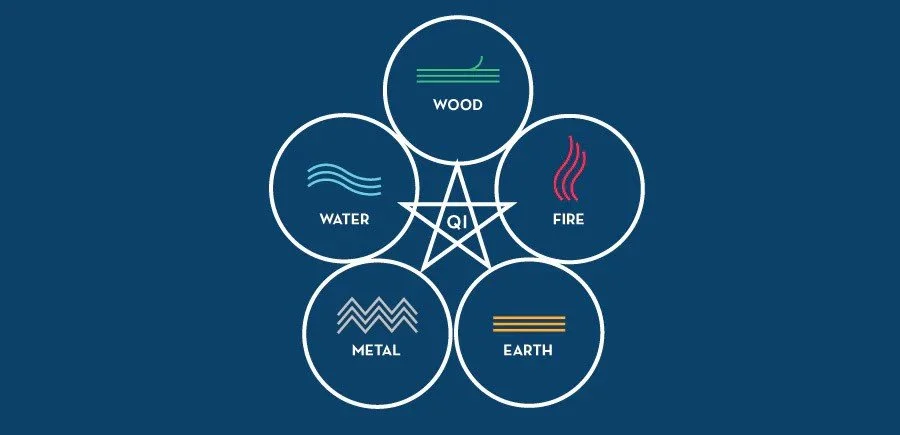The Five Elements: Autumn and the Metal Element
You can begin to feel it in the air, as summer’s brightness and fullness begin that subtle shift toward contraction. The sun’s rays no longer linger into the later evening hours and the apparent growth of summertime slows down, leading to an inevitable about-face toward decay. This cyclical rhythm of nature is evident all around us, from vividly colored leaves that soon fall from their branches to the faithful re-introduction of the pumpkin spiced latte at your local coffee shop.
A key concept in Chinese medicine is Wu Xing (pronounced 'woo-shing'), the theory of the Five Phases or Five Elements. Wu translates to 'five,' and xing means 'move,' suggesting movement or process. These are often better understood as five dynamic phases rather than static elements, reflecting natural cycles and transformations. For clarity, I’ll use the term 'phase' throughout the rest of this post.
These phases and their relationship to one another are fundamental in the understanding of Chinese medicine. They represent dynamic processes and cycles in nature that are fundamental to understanding health and balance. Each has its particular associations - specific organs, emotions, physiological functions, and seasons all fall under the influence of a phase within the cycle. Fire is associated with the heart organ, water with winter, wood with the color green, and so on. Metal’s corresponding season is Autumn.
Consider the cycle in the image above. Moving clockwise reflects the natural flow. Water corresponds to winter, symbolizing contraction, depth, and introspection. Wood represents growth and renewal, aligning with spring’s energy of rebirth. Fire embodies effulgence and peak activity, fitting for summer’s vibrant energy. Earth represents 'late summer,' the transition between summer’s peak and the start of autumn, embodying stability, nourishment, and the time of harvest.
This leaves us with autumn. Just as autumn is a time when nature lets go of what’s no longer needed—trees shedding leaves, plants retracting energy inward metal embodies the process of letting go to create space, to purify, and to refocus. Metal is also linked to the lungs, an organ responsible for taking in what is essential (like air) and releasing waste, mirroring autumn’s invitation to retain only what is valuable and let go of the rest. Metal’s energy supports introspection, helping us find clarity and prepare for the inward, restorative energy of winter.
The Lungs are traditionally called the ”tender organ”(1.) In The Web that Has No Weaver , author Ted Kaptchuk says they are called the tender organ “because they are easily affected by fleeting events, whether it is respiration, an acute cold or flu…”(2.) The lungs are our first point of contact with the external environment, making them particularly vulnerable to airborne pathogens and seasonal changes. And as temperatures cool in the autumn there is less moisture in the air, leading to dryer conditions and easier entry for those pathogens.
Emotions are essential to the health and vitality of each organ within the Five Phase cycle; an imbalance in any emotion can adversely impact its corresponding organ, and disruptions in an organ’s function can, in turn, affect emotional well-being. Sadness and grief are closely linked to the health of the lungs. When one is overwhelmed by grief, it’s common to feel physically weighed down, which has an effect on the lungs’ natural energy flow. Prolonged sadness can weaken lung function, making us more vulnerable to issues like fatigue, shallow breathing, or even catching colds. So in the Chinese medicine perspective, caring for lung health includes tending to our emotional well-being, allowing ourselves space to process and release emotions in a healthy way.
Here are some suggestions for staying healthy and maintaining proper balance during this season
Start to reduce intake of cooling foods, such as smoothies, iced drinks, and raw salads and invite warming foods into your diet - soups, stews, roasted root vegetables, fall spices, warm/hot drinks, or steamed vegetables.
Wear a neck warmer or scarf regularly. Autumn is also associated with wind, which in TCM theory is a primary cause of illness. It’s said that a main entry point for wind is the back of the neck, so wearing a suitable accessory can help protect any pathogen from invading.
Spring isn’t the only season to clean. It can help do deep clean and even find items that you have considered getting rid of, giving away, or donating. Go through your wardrobe and donate the clothes you do not wear anymore. Delete old and unused files on your computer. Make room on your smartphone by deleting old photos. Find some time to pare down and refine.
Some reflection of sadness, grief, or any difficult emotions is encouraged in autumn. Is there anything that can gently be released that is not serving your highest self?
Breathe. Take a moment to invite more intentional, deeper breaths into your lungs, strengthening your connection with each inhale and the physical sensation of breathing. For this practice, breathing through the nose is ideal—it helps warm and moisten the air, enhancing each breath.
An easy and approachable Qi Gong exercise to cleanse the Lungs (click for video link)
1. Ma Ruo-shui, The Theoretical Foundations of Traditional Chinese Medicine [62], pg. 35
2. Kaptchuk, T. J. (2000). The Web That Has No Weaver. Contemporary Books.
